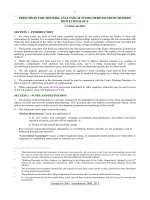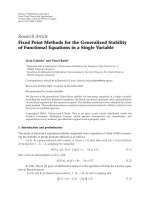Developing critical capacities for the efficient use of public investments in infrastructure to support trade and economic development in vietnam
Bạn đang xem bản rút gọn của tài liệu. Xem và tải ngay bản đầy đủ của tài liệu tại đây (4.11 MB, 392 trang )
DEVELOPING CRITICAL CAPACITIES FOR THE EFFICIENT USE
OF PUBLIC INVESTMENTS IN INFRASTRUCTURE TO SUPPORT
TRADE AND ECONOMIC DEVELOPMENT IN VIETNAM
DANG THUY HUONG GIANG
NATIONAL UNIVERSITY OF SINGAPORE
2014
DEVELOPING CRITICAL CAPACITIES FOR THE EFFICIENT USE
OF PUBLIC INVESTMENTS IN INFRASTRUCTURE TO SUPPORT
TRADE AND ECONOMIC DEVELOPMENT IN VIETNAM
DANG THUY HUONG GIANG
BSc. (Economics), National Economics University, Vietnam
MSc. (Project Management), National University of Singapore
A THESIS SUBMITTED
FOR THE DEGREE OF DOCTOR OF PHILOSOPHY
DEPARTMENT OF BUILDING
NATIONAL UNIVERSITY OF SINGAPORE
2014
DECLARATION
I hereby declare that this thesis is my original work and it has been written by me in
its entirety. I have duly acknowledged all the sources of information which have been
used in the thesis. This thesis has also not been submitted for any degree in any
university previously.
Dang Thuy Huong Giang
7
th
April 2014
i
ACKNOWLEDGEMENTS
I would like to express my sincere gratitude to my supervisor, Professor Low Sui
Pheng. I am deeply grateful to him for all his research guidance. Professor Low’s
advices and continuous support and encouragement had been invaluable to the
completion of my research. Besides, his kind understanding and patience really helped
me overcome hard times throughout my research.
I wish to express my grateful thanks to Professor George Ofori and Dr. Goh
Bee Hua, my thesis committee members. Their constructive comments and advices on
my research had always been very helpful.
My research was funded by the scholarship from the Department of Building,
School of Design and Environment, National University of Singapore. I would like to
acknowledge the support of the Department. I am very grateful for both academic and
financial assistance the Department has provided.
I would like to thank my research participants for answering my questionnaire
survey and agreeing to be interviewed. I would like to thank my friends and
colleagues in Vietnam and in Singapore for their help with my study.
Finally, I wish to thank my family. I would never have been able to finish the
thesis without their continuous support and encouragement throughout my long
journey.
ii
Contents
ACKNOWLEDGEMENTS i
Contents ii
SUMMARRY vii
List of Figures x
List of Tables xii
List of Abbreviations xiv
CHAPTER 1 INTRODUCTION 1
1.1 Research problem 1
1.2 Research scope 3
1.3 Research aim and objectives 5
1.4 Research methodology 5
1.5 Research significance 6
1.6 Organization of the thesis 8
CHAPTER 2 THEORIES OF ECONOMIC DEVELOPMENT 11
2.1 Introduction 11
2.2 Goals of economic development 11
2.2.1 Growth of gross national product 11
2.2.2 Quality of life 12
2.2.3 Sustainable development 14
2.2.4 The millennium development goals 15
2.3 The evolution of economic development thoughts 16
2.3.1 Early views about the nature of economic society and prosperity 16
2.3.2 Classical theories of economic development 18
2.3.2.1 The linear-stages-of-growth models 18
2.3.2.2 Structural-change models 19
2.3.2.3 International-dependence models 21
2.3.2.4 Neoclassical counter-revolution models 23
2.3.3 Contemporary theories of economic development 24
2.3.3.1 New growth theory 24
2.3.3.2 Theory of coordination failure 26
2.4 Summary 28
CHAPTER 3 CONSTRUCTION AND ECONOMIC DEVELOPMENT 32
3.1 Introduction 32
iii
3.2 Some basic concepts of the construction industry 32
3.2.1 Construction as an economic activity 32
3.2.2 Construction products 34
3.2.3 Structure of the construction industry 36
3.3 Major economic factors influencing construction activity 38
3.3.1 Instability of demand 38
3.3.2 Main construction inputs 40
3.3.2.1 Labour 40
3.3.2.2 Equipment and construction technology 41
3.3.2.3 Building materials 43
3.3.3 Sources of finance 44
3.4 Construction and aggregate output 45
3.4.1 Capital formation 45
3.4.2 National income 49
3.4.3 Other observations 52
3.5. Construction and sectoral output 54
3.5.1 Backward linkages 55
3.5.2 Forward linkages 55
3.6 Construction and macroeconomic stabilization 57
3.7 Government institutions for construction industry development 59
3.8 Conclusions 62
CHAPTER 4 TRADE AND ECONOMIC DEVELOPMENT 64
4.1 Introduction 64
4.2 Trade between nations and some general features 64
4.3 International trade and economic development 66
4.4 International market access issues and trade policies for developing countries 73
4.5 Trade policy institutions 77
4.6 Summary 79
CHAPTER 5 PUBLIC INVESTMENTS IN INFRASTRUCTURE FOR TRADE
AND ECONOMIC DEVELOPMENT 81
5.1 Introduction 81
5.2 Theory of coordination failure and role of government 81
5.3 Public investments in infrastructure and knowledge gap 83
5.4 Infrastructure planning and implementing in developing countries 87
5.4.1 Problems in infrastructure planning 87
iv
5.4.2 Problems in the implementation of infrastructure plans 89
5.5 Conclusions 93
CHAPTER 6 VIETNAM – ECONOMIC, TRADE AND INFRASTRUCTURE
OVERVIEW 96
6.1 Introduction 96
6.2 Vietnam – Country and economic overview 96
6.2.1 Geography and population 96
6.2.2 Economic overview 98
6.3 Integration into the world economy 106
6.3.1 Trade liberalization 106
6.3.2 International trade and economic growth 111
6.4 Infrastructure development 115
6.4.1 Infrastructure related indicators compared to other Asian countries 115
6.4.2 Government planning on infrastructure development 122
6.5 Construction industry 124
6.5.1 Construction and economic growth 124
6.5.2 Construction labour, materials and equipment 127
6.5.3 Legal environment 133
6.5.4 Industry structure for infrastructure development 135
6.5.5 National professional organizations 139
6.5.6 Infrastructure construction 141
6.5.6.1 Infrastructure investment planning 141
6.5.6.2 Infrastructure project implementation 142
6.6 Government institutions involved in the development planning process 147
6.6.1 Overview of the governmental system 147
6.6.2 Coordination of planning across ministries 149
6.6.2.1 Development plans 149
6.6.2.2 Planning process 150
6.6.3 Ministries in construction, infrastructure and trade sectors 153
6.6.3.1 Ministry of Planning and Investment (MPI) 154
6.6.3.2 Ministry of Construction (MoC) 154
6.6.3.3 Ministry of Natural Resources and Environment 157
6.6.3.4 Ministry of Transport (MoT) 158
6.6.3.5 Ministry of Information and Communications (MoIC) 159
6.6.3.6 Ministry of Industry and Trade (MoIT) 159
v
6.7 Conclusions 161
CHAPTER 7 RESEARCH METHODOLOGY 164
7.1 Introduction 164
7.2 Qualitative versus quantitative methods 164
7.3 Research design 167
7.4 Longitudinal survey 168
7.5 Questionnaire survey 171
7.5.1 Data collection 171
7.5.2 Data analysis 176
7.6 In-depth interviews 184
7.7 Two-stage validation 186
7.8 Summary 188
CHAPTER 8 DATA ANALYSIS AND DISCUSSIONS 190
8.1 Introduction 190
8.2 Longitudinal analysis 190
8.3 Factor analysis 193
8.3.1 Sample profile 193
8.3.2 Ranking of problems’ occurrence and criticality 195
8.3.3 Factor analysis of problems’ occurrence 203
8.3.3.1 Assumptions in factor analysis 203
8.3.3.2 Choosing factor models and number of factors 208
8.3.3.3 Factor interpretation 215
8.4 Structural equation modeling (SEM) 218
8.4.1 Hypotheses and the model 218
8.4.2 Evaluation of the measurement model 223
8.4.3 Evaluation of the structural model 226
8.4.4 Interpreting relationships 229
8.5 Interviews and discussion 231
8.5.1 Profile of interviewees 231
8.5.2 Inadequate forecasting capacity 232
8.5.3 Lack of transparency and accountability in infrastructure development 234
8.5.4 Lack of an effective land acquisition framework 239
8.5.5 Insufficient building capacity of local firms 244
8.5.6 Insufficient institutional capacity of the government 251
8.6 Summary 259
vi
CHAPTER 9 CONCLUSIONS 260
9.1 Introduction 260
9.2 Major findings 261
9.2.1 Efficiency level of public investments in infrastructure 261
9.2.2 Factors affecting the efficient use of public investments in infrastructure 262
9.3 Recommendations 269
9.3.1 Institutional capacity of the government 269
9.3.2 Transparency and accountability 271
9.3.3 Land acquisition 273
9.3.4 Building capacity of local firms 274
9.4 Validation 277
9.5 Contributions and implications 286
9.5.1 Theoretical contributions 286
9.5.2 Practical policy implications 289
9.6 Limitations of the research 292
9.7 Suggestions for future research 293
Appendix 1 – Questionnaire 295
Appendix 2 – Interview questions 302
Appendix 3 – Samples of Questionnaire responses 303
Appendix 4 – Samples of interview records 327
References 348
vii
SUMMARRY
The thesis studies critical factors affecting the efficient use of public investments in
infrastructure to support trade and economic development. In striving for that goal,
the study reviewed the literature on construction and economic development,
international trade theories, and infrastructure development. The literature review
provided an understanding of the linkages between the economy, infrastructure and
trade growth. The literature has shown a positive relationship between trade and
economic development. Stimulating trade has been one of the major policies in
developing countries. However, the under-performance of the infrastructure systems
that links these countries with their international markets is considered one of the
major concerns. Investments in infrastructure have increasingly been used to improve
the infrastructure quality, thus stimulating trade and economic growth in developing
countries. Nevertheless, a number of infrastructure challenges faced by developing
countries remain. This raises the question about the efficiency in the use of public
investments in infrastructure.
Examining how to use public investments in infrastructure more efficiently to
support trade and economic development, this study found the answer in the way
infrastructure of a country is planned and built. This study also attempts to isolate key
factors in the process that could limit the efficient use of public investments in
infrastructure. From the literature review, these factors could be categorized into two
groups: factors in the planning process and factors in the implementation process. In
the planning process, these factors include inadequate capacity for estimating and
monitoring of rates of return of infrastructure projects; politicized decision making;
transparency and accountability problems; and institutional weaknesses in decision-
viii
making. In the implementation process, these factors include lack of political
commitment in the implementation of infrastructure development plans; problems in
land acquisition; corruption in infrastructure construction; shortages of local
construction firms’ capabilities and resources; and institutional and legal weaknesses
in infrastructure construction.
The thesis discusses these factors in the case of Vietnam. A longitudinal
survey was carried out to examine the developmental trends of the efficiency of
public investments in infrastructure construction to support trade and economic
growth over time. A questionnaire survey and in-depth interviews with respondents
from both government agencies and non-government agencies were conducted to
identify key factors affecting the efficient use of the public investments. Respondents
from the government sector were selected from relevant government agencies
involved in policy making as well as planning for construction, infrastructure and
trade of Vietnam. Respondents from non-government agencies included financial
institutions, traders, developers, consultants and contractors involved in investing and
delivering infrastructure, as well as in utilizing infrastructure services for trading
activities. There are four major factors that the thesis found critical to the current use
of public investments in infrastructure in Vietnam including institutional capacity of
the government, transparency and accountability in infrastructure development, land
acquisition and building capacity of local firms. A model of the impacts of these
factors on the efficient use of public investments in infrastructure was examined and
validated. Among these factors, poor institutional capacity of the government lies at
the root of the inefficient use of public investments in infrastructure. The current
fragmented way of planning and implementing infrastructure policies requires better
coordination across sectors and levels.
ix
Findings of the study supplement the understanding of the role of government
in the theory of coordination failure in economic development. Major theoretical
implication of the findings is that there is a strong need for the government to take the
lead in ensuring that public investments in infrastructure lead to long-term and
sustainable growth. Practical contributions of the study are also achieved by more
precisely pinning down constraints on state capacities across infrastructure planning
and delivery, explaining the effects of these constraints, and illuminating the potential
scope for reform in policy and planning for infrastructure development.
x
List of Figures
Figure 2.1 The evolution of development thoughts 30
Figure 3.1 Effect of increases in capital stock on the production possibility frontier 46
Figure 3.2 Share of construction in GNP and per capita GNP 51
Figure 4.1 Time-line of major theoretical viewpoints on the role of international trade
in economic development 80
Figure 5.1 Factors affecting the efficient use of infrastructure investments for trade
and economic development from the literature review 95
Figure 6.1 Geographical map of Vietnam 97
Figure 6.2 Vietnam’s GDP growth (at constant 1990 prices US$) 103
Figure 6.3 Structure of Vietnam’s GDP at 1994 prices by economic activities 104
Figure 6.4 Structure of Vietnam’s GDP at current prices by ownership (%) 104
Figure 6.5 Vietnam’s GNI per capita, Atlas method (current prices US$) 105
Figure 6.6 Contribution of foreign trade to Vietnam’s GDP 112
Figure 6.7 Contribution of FIEs in Vietnam’s total export value of goods (%) 113
Figure 6.8 Costs to export in Vietnam and some neighboring countries 117
Figure 6.9 Costs to import in Vietnam and some neighboring countries 118
Figure 6.10 Supply and demand at Ho Chi Minh City ports 119
Figure 6.11 Global competitiveness score of Vietnam 120
Figure 6.12 Photos of the poor infrastructure of Vietnam 122
Figure 6.13 Vietnam’s growth by economic activities 125
Figure 6.14 Contribution of Vietnam’s construction industry to GDP 125
Figure 6.15 Vietnam’s GFCF in GDP 126
Figure 6.16 Vietnam’s labour productivity in construction industry 130
Figure 6.17 Labour productivity and average income of labour in the construction
industry of Vietnam 131
Figure 6.18 Average price index for housing and material construction in Vietnam . 132
Figure 6.19 Vietnam’s national planning system 150
Figure 6.20 Vietnam’s planning process at central level 151
Figure 6.21 Time-line of major economic policies, significant infrastructure
development events and related institutional changes 163
Figure 7.1 Path model example 181
Figure 7.2 Research design 189
xi
Figure 8.1 Marginal effect of public investments in infrastructure for supporting trade
and economic growth in Vietnam 193
Figure 8.2 Model of the inefficient use of public investments in infrastructure in
Vietnam 222
Figure 8.3 Estimated structural equation model of factors affecting the use of public
investments in infrastructure 230
Figure 9.1 Major factors affecting the efficient use of public investments in
infrastructure in Vietnam 268
Figure 9.2 Framework for developing capacities for the efficient use of public
investments in infrastructure in Vietnam 285
Figure 9.3 Theoretical contributions of the study 288
xii
List of Tables
Table 6.1 Significant changes in legal and institutional framework for trading
activities and related policies of Vietnam since Doi Moi 109
Table 6.2 Comparison of quality of overall infrastructure of Vietnam and some
neighboring countries 116
Table 6.3 Rankings of infrastructure quality of Vietnam 116
Table 6.4 Time to export and to import of Vietnam and some neighboring countries117
Table 6.5 Total outputs of major building materials in Vietnam from 2000 to 2007 . 128
Table 6.6 Forecasts of capacities and outputs of key building materials in Vietnam
from 2010 to 2020 128
Table 6.7 Member national associations of VFCEA 140
Table 6.8 Major factors explaining the poor performance of large construction
projects in Vietnam 146
Table 6.9 Ministries responsible for trade, infrastructure and construction sectors 153
Table 7.1 Number of divisions and units under relevant ministerial departments 174
Table 8.1 Efficiency of public investments in infrastructure construction to support
trade and economic growth 191
Table 8.2 Questionnaire return rate 194
Table 8.3 Type of management levels 194
Table 8.4 List of variables affecting the efficient use of public investments in
infrastructure 195
Table 8.5 Median occurrence rating of problems 197
Table 8.6 Median criticality rating of problems 198
Table 8.7 Hypothesis test on the median of criticality ratings 201
Table 8.8 Correlation matrix 205
Table 8.9 Anti-image correlation 207
Table 8.10 Component analysis 208
Table 8.11 Factor matrix 210
Table 8.12 Rotated factor-loading matrix 211
Table 8.13 Rearrangement of rotated factor matrix 212
Table 8.14 Ranking of the outcomes of the inefficient use of public investments in
infrastructure 219
Table 8.15 Measured indicator loadings 225
Table 8.16 Squared correlations of constructs 225
Table 8.17 Indicators’ cross loadings 226
xiii
Table 8.18 Estimated path coefficients and t-value 228
Table 8.19 Endogenous constructs’ cross validated redundancy 229
Table 8.20 Profiles of interviewees 231
xiv
List of Abbreviations
ADB Asian Development Bank
APEC Asia-Pacific Economic Cooperation
ASEAN Association of Southeast Asian Nations
AVE Average Variance Extracted
CB-SEM Covariance-based SEM
ECE United Nations Economic Commission for Europe
EVN Electricity of Vietnam
FDI Foreign Direct Investment
FIEs Foreign-Invested Enterprises
GATS General Agreement for Trade in Services
GATT General Agreement on Tariffs and Trade
GCI Global Competitiveness Index
GCR Global Competitiveness Report
GDP Gross Domestic Product
GFCF Gross fixed capital formation
GNI Gross National Income
GNP Gross National Product
GSO General Statistics Office of Vietnam
HDI Human Development Index
HÐBT Ministers’ Committee
MDGs Millennium Development Goals
MoC Ministry of Construction
MoF Ministry of Finance
MoIC Ministry of Information and Communications
MoIT Ministry of Industry and Trade
MoT Ministry of Transport
MPI Ministry of Planning and Investment
MSA Measure of Sampling Adequacy
NICs Newly Industrializing Countries
ODA Official Development Assistance
PIP Public Investment Program
xv
PLS-SEM Partial Least Squares SEM
PMU Project Management Unit
PNTR Permanent Normal Trade Relations
PPP Public Private Partnership
SEDP Socio-Economic Development Plan
SEDS Socio-Economic Development Strategy
SEM Structural Equation Modeling
SOEs State-Owned Enterprises
SPS Sanitary and Phytosanitary Standards
SPSS Statistical Package for Social Sciences
TEC & QMB Transport Engineering Construction and Quality Management Bureau
TRIPS Trade Related Intellectual Property Rights
UNIDO United Nations Industrial Development Organization
UNSD United Nations Statistics Division
VACC Vietnam Association of Construction Contractors
VBRA Vietnam Bridge and Road Association
VEC Vietnam Expressway Corporation
VFCEA Vietnam Federation of Civil Engineering Associations
VNPT Vietnam Posts and Telecommunications Group
VNR Vietnam Railways Corporation
VUSTA Vietnam Union of Science and Technology Associations
WEF World Economic Forum
WTO World Trade Organization
1
CHAPTER 1 INTRODUCTION
1.1 Research problem
International trade today stands as a focus of the development agenda in many
countries of the world. Notably, international trade in developing countries has
recently grown faster than in developed ones (World Trade Organization, 2010). In
2010, the growth rates of exports in developed countries and developing countries
were 13% and 17% respectively. Likewise, the 2010 growth rate of imports in
developing countries (18%) was higher than that in developed countries (11%)
(World Trade Organization, 2010). However, integrating into the world trade system
is still a challenging task for developing countries. Traditional trade issues are barriers
to trade (tariffs and quotas), which remain high in many developing countries. As
developing countries increase their integration into the world economy, these
countries are facing new issues. They are “behind-the-borders” issues, including the
role of infrastructure and governance (Hoekman et al., 2002).
The role of infrastructure in supporting trade as well as infrastructure issues in
the developing countries have been addressed in a number of empirical studies. In
these studies, infrastructure is regarded as one of the determinants of international
competitiveness, which directly impact the ability of countries to engage in
international trade, and to compete for foreign direct investments (APEC Economic
Committee, 1997; Nwankwo, 2000; Kohsaka, 2007). The poor quality and inadequacy
of infrastructure are therefore considered one of the major marketing issues and
challenges in many developing countries (Batra, 1997). As a result, attention has
increasingly been given to strategic infrastructure development in the developing
countries. Most studies on strategic infrastructure development for developing
2
countries examined issues related to financing issues for infrastructure development,
including under-investment in infrastructure, allocations of public capital, public
resource constraints and private financing (Mundial, 1994; Venables, 2004;
Demetriades, 2007; Kohsaka, 2007; Flanagan and Jewell, 2009).
Similarly, the strong correlation between construction (including infrastructure)
and economic development in the developing countries has long been studied (Turin,
1969; World Bank, 1984). Tan (2002) has summarized the implications of the early
studies of the relation between construction and economic development in the less
developed countries and noted that construction is a “potential” agent of economic
development.
There are, however, other concerns about the infrastructure development in
developing countries, including waste, cost overruns and benefit shortfalls, or
corruption in large infrastructure projects (Flyvbjerg, 2007; Sohail and Cavill, 2008).
These concerns suggest that there are more major management issues with
infrastructure development than just project financing issues. Several studies focus on
the planning aspect of infrastructure development (Hossain, 2000; Flyvbjerg, 2007;
Mustajab, 2009; Marshall, 2011). However, little is known about how the entire
management system (including planning and delivery) of the government can use
public investments in infrastructure more efficiently to support trade and economic
development. To this end, it is pertinent to examine how infrastructure is planned and
built in a typical developing country, and what key variables are there in the system
limiting the efficient use of public investments in infrastructure.
Vietnam has shown constant efforts and commitments to stimulate the
integration into the world trading systems and heavy investments in infrastructure for
economic development over the past decades (see Chapter 6). However, compared to
3
other regional countries such as Singapore, Malaysia, Thailand, Indonesia and the
Philippines, Vietnam’s GNI per capita is the lowest (World Bank, 2010). Similarly,
there is a large gap in infrastructure between Vietnam and these neighbouring
countries. According to the World Economic Forum (Schwab, 2008, 2009, 2010),
infrastructure quality in Vietnam was ranked the poorest compared to that of
Singapore, Malaysia, Thailand, Indonesia and the Philippines (more details in Chapter
6). The weaknesses of infrastructure in Vietnam have been identified as the biggest
hindrance for doing business in the country (Nguyen and Dapice, 2009). It is therefore
critical for Vietnam to develop plans and policies to overcome these challenges. As
the country continues to rely on government planning to foster economic development,
which is common in developing economies (Todaro and Smith, 2009), the case of
Vietnam could bring out key insights that go beyond the case under study.
1.2 Research scope
In examining the main research question of what factors limit the efficient use of
public investments in infrastructure to support trade and economic development in
Vietnam, the approach taken in this study has several features:
- The research focuses on macro-level or statewide variables rather than micro- or
agency-level variables. The approach is needed since public investments in
infrastructure (national infrastructure investment and policy) are initially
determined at macro-level in response to or stimulate changes in the economic
environment.
- Trade in this study is referred to as trade between nations or international trade,
since this study focuses on a country’s perspective on trade rather than on an
individual’s or firm’s perspective.
4
- There are two main types of infrastructure, economic infrastructure supporting
economic activities of the national economy and social infrastructure supporting
social development. Since the study focuses on infrastructure built to support
economic development and trade, the scope of this study is restricted to economic
infrastructure (as defined by World Bank (1994)), including power,
telecommunications and transportation.
- Infrastructure construction in this study is referred to as the production process of
the built environment, including various activities from conception through
design to execution that transforms various resources into constructed facilities
(Ive and Gruneberg, 2000).
- In economics, efficiency is defined as the use of resources for maximizing the
production of goods and services (O'Sullivan and Sheffrin, 2004). In this study,
the efficient use of public investments in infrastructure refers to the use of public
investments in infrastructure so as to maximize the competitiveness of a nation in
terms of infrastructure development. According to the World Economic Forum,
the competitiveness of a nation in terms of infrastructure development is reflected
in the quality and extensiveness of infrastructure networks that integrate the
national market and connecting it at low cost to markets in other countries and
regions (Schwab, 2009).
- Developing countries in this study are referred to as low-income and middle-
income economies as classified by the World Bank (2011a). The other group
includes developed countries, which have high incomes and high-living standards
(World Bank, 2011a).
5
1.3 Research aim and objectives
The main aim of this study is to analyse the use of public investments in infrastructure
to support trade and economic development in Vietnam. The objectives of this study
are:
- To review how public investments in infrastructure are used to support trade and
economic growth in the literature;
- To examine how infrastructure is planned and built in Vietnam;
- To evaluate the level of efficiency of public investments in infrastructure in
supporting trade and economic growth in Vietnam;
- To explore the key variables in the process of planning and plan implementation
that limit the efficient use of public investments in infrastructure in Vietnam; and
- To make recommendations on capacity building to address issues that critically
limit the efficient use of public investments in infrastructure to support trade and
economic growth in Vietnam.
1.4 Research methodology
The research methodology for this study is discussed in Chapter 7. However, it is
useful to identify some features of the methodology at the beginning of this study:
A longitudinal survey of public investments in infrastructure was used to explore
the extent to which public investments in infrastructure was efficiently used in
Vietnam;
A questionnaire survey was adopted in this study to explore the key variables
limiting the efficient use of public investments in infrastructure perceived by
concerned parties. The sample included government officials, developers,
bankers, traders, consultants and contractors involved in policy making and
6
planning, and delivering as well as in utilizing infrastructure. A five-point Likert
scale was applied for questions relating to the degree of occurrence and influence
of factors;
In-depth interviews were carried out to explore the ways to address key factors
identified from the questionnaire survey. In addition, strategic planning
documents, programme-related documents including final reports, evaluation
reports and other documents were collected as alternative sources for cross-
checking. Information collected from the interviews formed the main basis for the
study to make recommendations to improve the efficient use of public
investments in infrastructure.
Data analysis included both quantitative (factor analysis and structural equation
modeling) and qualitative (thematic content analysis) methods as explained in
Chapter 7.
A two-stage (quantitative and qualitative) validation was conducted to validate the
results.
1.5 Research significance
Economists have long agreed that the productive capacity of an economy depends on
an adequate level of capital formation (Harrod, 1948; Rostow, 1960). Investments in
infrastructure are expected to promote trade and other economic activities.
Considerable financing is required as demand for infrastructure in developing
countries to support trade and economic growth is increasing rapidly. The question of
project financing is thus the major subject discussed in the literature on infrastructure
development (Fay and Yepes, 2003; Davis, 2008; Arnold, 2011). However, as
important as the question of project financing, developing countries are facing the
7
question of efficiency. The poor performance of infrastructure investments (cost
overruns, benefit shortfalls and waste) can have negative impacts on the economy and
be costly to fix (Burns and Grebler, 1984; Devarajan et al., 1996; Flyvbjerg, 2008).
Therefore, how efficiently public investments in infrastructure can be used should be
considered. More importantly, what factors are limiting the efficient use of public
investments in infrastructure should be explored. The research is thus needed to
provide knowledge on how to better use public investments in infrastructure to benefit
the economy.
The research explored the use of public investments in infrastructure at the
macro-level in order to identify constraints across government departments and policy
spheres. Although development economists have long been debating the role of
markets over government (Meier, 2000), infrastructure investment is provided
principally by the public sector worldwide (Estache, 2006). Besides providing
infrastructure to promote private economic activities, governments also often use
infrastructure spending as a counter-cycle tool for macroeconomic stabilization
(Gruneberg, 1997; Hillebrandt, 2000). Therefore, examining constraints across
government departments and policy spheres, thus assisting government to put in place
required capacities to improve the public sector performance is critical for developing
countries. These insights are also valuable for policy makers to develop better
infrastructure policies when financial resources are tight.
In addition, the study explored the use of public investments in infrastructure
by employing a macro-level approach in Vietnam that covers planning, budgeting,
inter-ministry and inter-local government cooperation, and delivery. Several studies
on infrastructure development in Vietnam (Long et al., 2004; Nguyen and Dapice,
2009) focus on one or two aspects of infrastructure development, rather than on an









